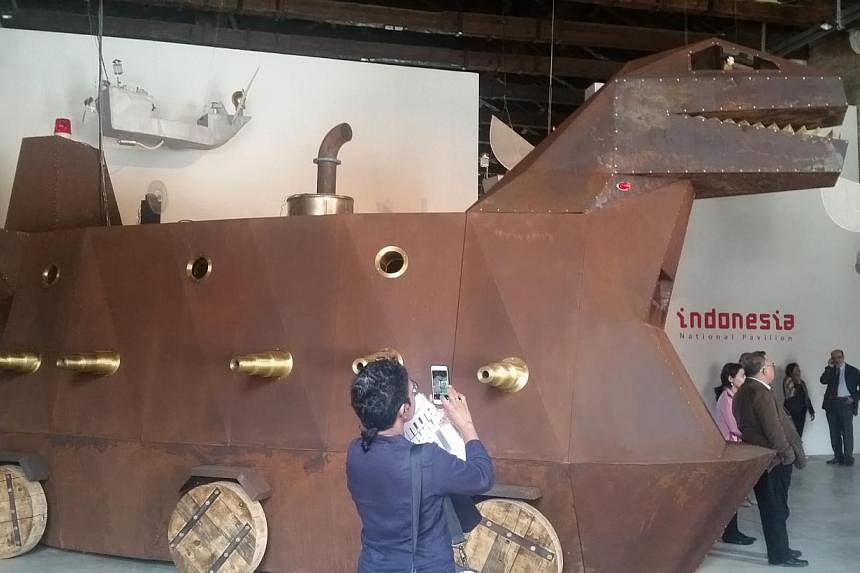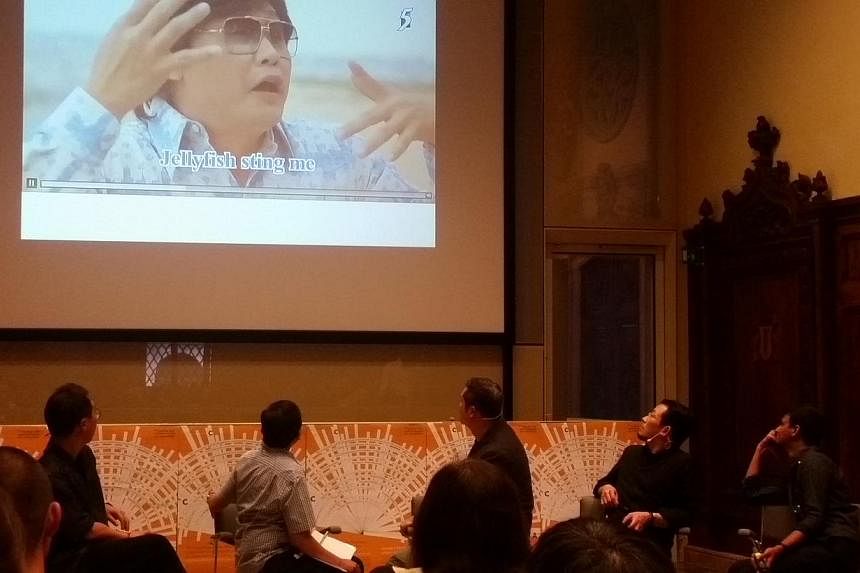Amid high-brow discussions of art, rising sea levels and contested maritime regions, Channel 5 actor Chen Tianwen's comic beach music video Sandcastle In My Heart stole the show on Saturday at Singapore's first-ever symposium at the Venice Biennale.
Over 100 artists, curators, collectors and academics applauded and laughed at the video shown by the curator for the Singapore Pavilion, Shabbir Hussain Mustafa, to illustrate how land reclaimed from the sea was also being physically and metaphorically absorbed into the identity of Singapore and Singaporeans - many of the island's natural beaches no longer exist because of land reclamation.
He was among 12 speakers at the two-hour event organised by Nanyang Technological University's Centre for Contemporary Art Singapore and titled The Geopolitical And The Biophysical: A Structured Conversation On Art And Southeast Asia In Context.
The session moderated by Singapore critic Lee Weng Choy and NTU CCA director Ute Meta Bauer featured artists and curators from the national pavilions of Singapore, Philippines, Indonesia and the Pacific Ocean island of Tuvalu, the smallest country with a national pavilion at the international arts festival.
Also taking the stage were Dr Eugene Tan, director of the National Gallery Singapore and two curators of collateral exhibitions: Doryan Chong, who is behind Hong Kong's showcase of Tsang Kin-Wah's The Infinite Nothing and Natasha Ginwala of My East Is Your West, a rare showcase that unites artists from India and Pakistan.
Themes of climate change, maritime boundaries, national identity as well as international positioning dominate each featured exhibition. For both collateral exhibitions, identity is a key issue with My East Is Your West imagining a reality where India and Pakistan did not separate into two countries in 1947. Meanwhile, curator Chong emphasised that Hong Kong's exhibition was not a national pavilion and neither was Tsang's immersive work, reminiscent of a storm, meant to reflect the political situation in the Special Administrative Region.
Then there was Taiwanese artist Vincent Huang's installation for Tuvalu, four pools connected by Venetian foot-bridges, which highlight the plight of the country of roughly 9,000 people. With climate change and rising sea levels, there is a real possibility it may soon cease to exist. It is a plight which speaks to Huang, as he pointed out that Taiwan's increasing global isolation due to China's claim on it means he could never have a national pavilion for his home.
Singapore's presentation Sea State, the culmination of 10 years work by artist and former national sailor Charles Lim, examines reclamation and expansion works and how these led to an island off the coast of Singapore, Pulau Sejahat, disappearing off maps.
The Philippines, which has a biennale pavilion after a 51-year gap, examines national identity via the hot contest to claim the waters of the South China Sea - known in Manila as the West Philippine Sea. Tie A String Around the World features a red velvet battleship by Jose Tence Ruiz, and the theme is inspired by a 1950s film about Genghis Khan's desire to conquer the world, created by Manuel Conde and Carlos Francisco. Mariano G. Montelibano reinterprets the film as a retelling of legend from the fishing tribes on Palawan Island, near Indonesia, with a soundtrack comprised of radio recordings from the disputed waters.
Indonesia's pavilion, another rare biennale outing from South-east Asia, is also a comment on how identity is interpreted and misinterpreted. Heri Dono's Voyage Trokomod is a giant Komodo dragon cum Trojan Horse, a martial tank-like machine containing historical Western artefacts and guarded by an aerial parade of Indonesian boats and vessels.
Dono inverts the Eurocentric perception of the East in his work. At the symposium, the 55-year-old shared the story of how, when he broke into the global art scene decades ago, he was asked whether he was from "East or West", meaning Communist or Capitalist countries. Indonesia was a signatory to the Non-Aligned Movement, which refused to align with either Soviet Russia or America, so, he said: "When I went to Europe, there was no space for me."
"I think until now it's still difficult to understand the East," he added to applause. "We have a United Nations but no united culture."
On this same topic, Singapore's Lim said it was important to have a national pavilion at an international event such as the Venice Biennale. "I've done a couple of biennales and every time you show your work it's under another curator. The national pavilion lets you show the work as you want it to be seen," he said.
During and after the session, representatives thanked NTU CCA Singapore for arranging this session which allowed them to interact. "I've been wanting to get to the Philippine Pavilion but no time," said Lim, echoing the other artists' comments that they had been rushed off their feet setting up their works.
Montelibano, 43, told The Straits Times that he was bowled over by the similarities between some of Lim's video work and his own installation in the Philippine Pavilion. Both explore how difficult it is to establish a maritime border and whether it is even meaningful to draw a line in the ocean, separating territories. "I think it's so interesting that both artists are exploring this concept of the border. There should be more interaction between us all," he said.


